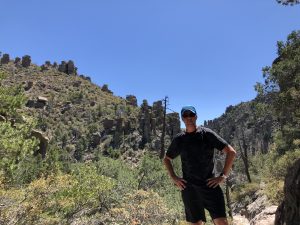 I just returned from running in Chiricahua National Monument, Sedona, Painted Desert, and Petrified Forest National Park, taking advantage of the late spring before the heat becomes too intense. Even so, though I got to Massai Point in Chiricahua through 90+ degree canyons and had around a liter of water left, I still had to slow down and walk out after running short of liquid nourishment two-thirds down. There is an eerie, uncertain nausea that hits when hydration runs low under high stress. Cliffs and steep ravines take on a wolfish quality. The mind works to control feet against stumbling and the lips get serrated edges of parched skin that bite off without relieving the dryness.
I just returned from running in Chiricahua National Monument, Sedona, Painted Desert, and Petrified Forest National Park, taking advantage of the late spring before the heat becomes too intense. Even so, though I got to Massai Point in Chiricahua through 90+ degree canyons and had around a liter of water left, I still had to slow down and walk out after running short of liquid nourishment two-thirds down. There is an eerie, uncertain nausea that hits when hydration runs low under high stress. Cliffs and steep ravines take on a wolfish quality. The mind works to control feet against stumbling and the lips get serrated edges of parched skin that bite off without relieving the dryness.
I would remember that days later as I prepped to overnight with a wilderness permit in Petrified Forest only to discover that my Osprey Exos pack frame had somehow been bent, likely due to excessive manhandling by airport checked baggage weeks earlier. I considered my options and drove eighty miles to Flagstaff to replace the pack, then back again.
I arrived in time to join Dr. Richard Carrier in an unexpected dive bar in Holbrook, Arizona as the sunlight turned to amber and a platoon of Navajo pool sharks descended on the place for billiards and beers. I had read that Dr. Carrier would be stopping there and it was convenient to my next excursion, so I picked up signed copies of his new book, The Scientist in the Early Roman Empire, as well as his classic, On the Historicity of Jesus, that remains part of the controversial samizdat of so-called “Jesus mythicism.”
If there is a distinguishing characteristic of OHJ it is the application of Bayesian Theory to the problems of historical method. How should we evaluate evidence that is inconclusive or obscured by vast gulfs of history? For Dr. Carrier the answer is fairly simple: use the most sound form of probabilistic reasoning we know of. That means evaluating claims based on their prior likelihoods of confabulation, enhancement, mythologization, and verisimilitude. That means adjusting the likelihoods of evidence based on these priors and expressing confidence with bounds rather than certainty. Most amazing is that this approach has not been the mainstream approach of historians, though it can be argued that the methods used in ancient historical analysis often boil down to Bayesian discounting, though without the deeper appreciation of the broader implications of ideas like global updating of belief.
Our conversation ranged widely, from variable geometry propellers for interdicting drift nets at sea to the influence of Persian Zoroastrian thought on Stoic philosophy; from accommodationism of Catholic, Positive Christian and Teutono-Indo-European mysticism in Hitler’s inner circle to gaming the Hugo award; from Lovecraft’s racism to Martin Amis’ protective view of Nabokov. In the end, I staggered a bit getting back to my hotel with my twin volumes, an odd sight for the rumbling truckers along Route 66, I think.
And here is a brief lecture on machine learning and deep learning that I prepared recently. It focuses especially on image processing using Deep Learning Neural Networks and, specifically, how Convolutional Neural Network architectures work. I intended to record the roughly one and three-fourths hours of discussion about it early this evening in a presentation to my son in college in Colorado, but the recording unfortunately failed. It can be said that the fundamental ideas of separability of data and optimal model inference continue the Bayes tradition, though with slightly different mechanisms. They are legitimately “effective procedures,” however, in that they give form, finally, to the mental mechanisms that we developed to combat irrationality in human thought.
ml-intro-4-28-18-v2